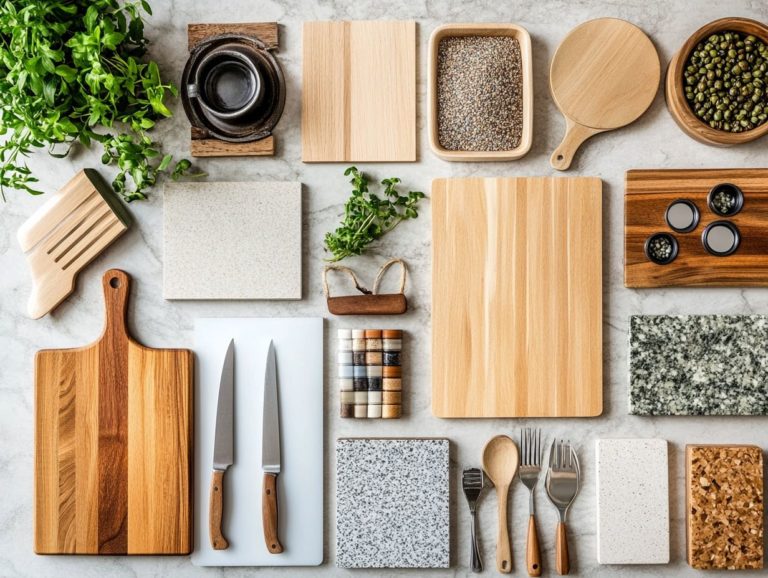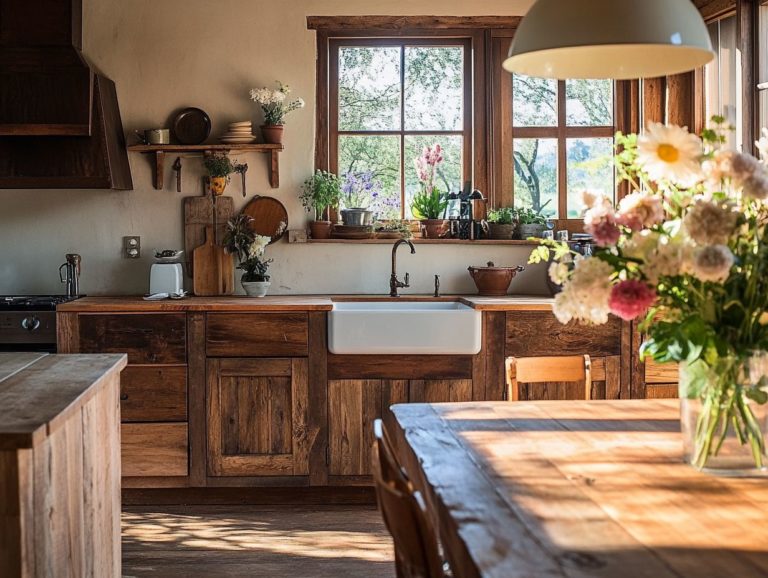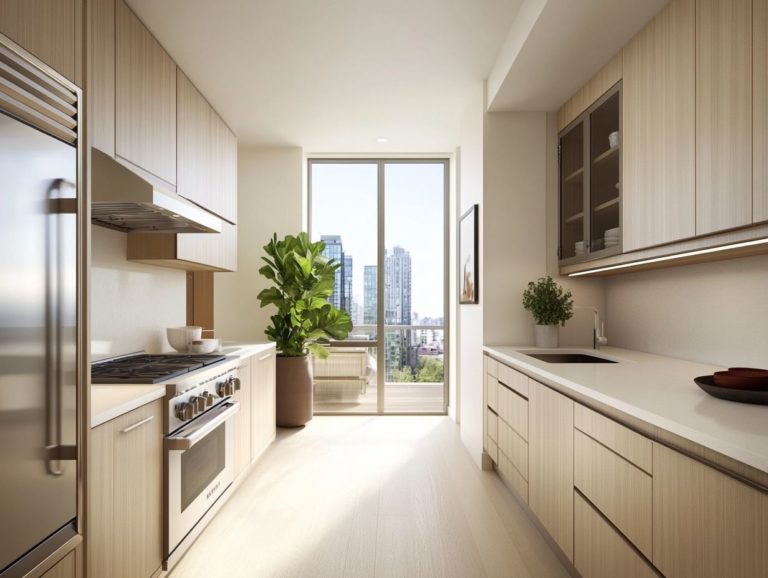How to Mix and Match Kitchen Materials Effectively
Creating a stunning kitchen isn’t just about picking the right appliances and colors; it’s all about the materials you choose. Get ready to explore the exciting world of kitchen materials!
From countertops to flooring, your selections profoundly influence both your kitchen’s functionality and its aesthetic appeal. You’ll discover key factors to consider for a cohesive design, along with inspiring combinations and practical tips to ensure your kitchen is beautiful and durable.
Dive in to uncover how you can transform your space with the perfect blend of materials!
Contents
- Key Takeaways:
- Understanding Kitchen Materials
- Benefits of Mixing and Matching Materials
- Factors to Consider When Mixing and Matching
- Examples of Effective Material Combinations
- Tips for Successfully Mixing and Matching Materials
- Frequently Asked Questions
- What is the key to effectively mixing and matching kitchen materials?
- Can I mix and match different materials for my kitchen countertop and backsplash?
- How do I choose the right color palette for my kitchen materials?
- Can I mix and match materials with different textures in my kitchen?
- Is it better to mix materials in a small or large kitchen?
- Can I mix materials in a rental kitchen?
Key Takeaways:

Unlock the secret to a stunning kitchen by mixing and matching materials! When choosing materials, consider design cohesion and durability to ensure a long-lasting look that complements your lifestyle. Follow the dos and don’ts to achieve a cohesive and visually appealing result.
Understanding Kitchen Materials
Understanding kitchen materials is essential for any kitchen remodel. The choice of countertops significantly impacts both the aesthetic appeal and practical benefits of your design.
Materials such as quartz and granite each bring unique characteristics that suit various styles and functions. Butcher block offers a warm touch, while stainless steel and concrete provide modern, durable surfaces capable of withstanding daily use.
Incorporating stone, wood, and elegant marble creates striking visual interest, enhancing the overall ambiance of your kitchen space.
Types of Materials and Their Properties
There are various materials available for kitchen countertops, each offering unique properties that cater to different styles and needs.
For example, quartz countertops, like those from Caesarstone, are renowned for their durability and low maintenance. This makes them ideal for busy households that want beauty without the hassle.
Granite, celebrated for its natural beauty and unique patterns, does require periodic sealing to keep it in top shape, as seen in options from brands like Cambria.
Butcher block brings a warm, inviting aesthetic that’s perfect for food prep. However, it can be prone to scratches and water damage if not properly cared for.
By understanding the pros and cons of these materials, you can make informed decisions that align with your lifestyle and design preferences.
Benefits of Mixing and Matching Materials
Mixing materials in your kitchen remodel elevates your design, providing a blend of beauty and practical benefits tailored to your unique preferences and functional needs.
By mixing materials, you can create a kitchen that’s both beautiful and functional!
Enhancing Functionality and Aesthetics

Combining different materials enhances your kitchen island’s functionality and infuses vibrant colors and textures that create a harmonious, engaging space.
Thoughtfully selecting surfaces—like pairing quartz countertops with warm wood cabinetry—achieves durability and an inviting atmosphere. Imagine a composite sink seamlessly integrated into a granite top; it simplifies cleaning while elevating your kitchen’s overall aesthetic.
Adding metal accents, such as brushed stainless steel, introduces a striking contrast while ensuring longevity. These design choices improve usability and enhance visual appeal, transforming your kitchen island into a central hub for cooking, gathering, and socializing.
Factors to Consider When Mixing and Matching
When you’re mixing materials in your kitchen design, it’s crucial to consider design cohesion, durability, and the unique maintenance requirements of each material.
This thoughtful approach will ensure your remodel is successful and enduring.
Design Cohesion and Durability
Design cohesion connects the visual elements of your kitchen. Durability ensures that your chosen countertops and surfaces stand the test of time.
Achieving harmony in your kitchen’s aesthetic goes beyond selecting appealing colors and patterns. It requires a careful selection of materials that complement one another.
By opting for a cohesive palette, you can elevate the overall ambiance. This makes the space feel more inviting and unified.
Practicality is just as important. Durable surfaces made from materials like quartz or granite enhance beauty while offering the resilience needed to withstand everyday wear and tear.
Aligning these essential aspects—visual appeal and functional strength—allows you to create a kitchen that is both stylish and built to last, effortlessly meeting the demands of daily life.
Examples of Effective Material Combinations
Expertly blending materials can elevate your kitchen into a true masterpiece.
Imagine the elegance of marble countertops paired with warm wood or the vibrancy of bold colors. These combinations can create stunning focal points that captivate the eye and enhance your space’s overall aesthetic.
Real-life Kitchen Inspirations

Explore the world of kitchen design through the lens of renowned visionaries like Studio McGee and Aqua Kitchen. They illustrate the art of material mixing to create spaces that are both functional and beautiful.
Imagine warm wood cabinetry paired with sleek marble countertops, resulting in a kitchen that radiates warmth and sophistication. By incorporating bold backsplash tiles alongside metallic fixtures, these designers elevate the aesthetic while maintaining practicality.
Designers like Harvey Jones and Naked Kitchens emphasize unique features such as handcrafted cabinetry combined with innovative storage solutions. This harmonious fusion enhances visual appeal while maximizing utility, demonstrating that a thoughtfully curated kitchen can serve as both a culinary haven and a stunning centerpiece for any home.
Tips for Successfully Mixing and Matching Materials
Successfully blending and contrasting materials requires an understanding of key tips and tricks. By following these guidelines, you can achieve a harmonious look in your kitchen design while considering both maintenance needs and aesthetic appeal.
Dos and Don’ts for a Cohesive Look
When considering mixing countertops and other materials in your kitchen remodel, following certain dos and don’ts can elevate both the aesthetic appeal and functionality of the space.
Make informed choices to create a cohesive look that ties the kitchen together. Start by selecting complementary colors that enhance your kitchen’s design. For instance, pairing warm wood tones with soft neutral countertops evokes a comforting ambiance.
Conversely, steer clear of clashing patterns or overly bold designs that could undermine your kitchen’s beauty. Strive for a harmonious balance by mixing textures thoughtfully, ensuring that each element supports the others while retaining its individuality.
Maintaining a consistent theme will guide you in crafting a space that is both stylish and practical, making your kitchen a true reflection of your taste.
Frequently Asked Questions
What is the key to effectively mixing and matching kitchen materials?

Finding the right balance is essential! Aim for a mix of functionality, style, and durability to ensure your materials complement each other.
Can I mix and match different materials for my kitchen countertop and backsplash?
Yes! As long as the materials have a cohesive color or design scheme, you can mix and match different materials for your countertop and backsplash. Just ensure they complement each other and create a unified look.
How do I choose the right color palette for my kitchen materials?
Start with a dominant color, like your cabinets or appliances. Then, pick complementary colors for other materials.
A color wheel can be a helpful tool to find colors that go well together.
Can I mix and match materials with different textures in my kitchen?
Yes! Combining different textures can create depth and visual interest in your kitchen. Just ensure the textures work well together and don’t clash.
Is it better to mix materials in a small or large kitchen?
You can mix materials in both small and large kitchens. In a small kitchen, stick to a limited color palette and similar textures for a cohesive look.
In a large kitchen, feel free to experiment with various materials and textures.
Can I mix materials in a rental kitchen?
Absolutely! You can mix materials in a rental kitchen, but consult your landlord first.
Consider using removable options like adhesive backsplash tiles or peel-and-stick wallpaper. These won’t damage the existing surfaces.





